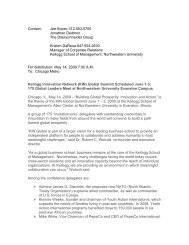KIN Global: Health and Wellness Prevention and Partnerships: What ...
KIN Global: Health and Wellness Prevention and Partnerships: What ...
KIN Global: Health and Wellness Prevention and Partnerships: What ...
You also want an ePaper? Increase the reach of your titles
YUMPU automatically turns print PDFs into web optimized ePapers that Google loves.
1979, it is estimated that 30 million lives have been saved. The program cost $25M for 12 years, but it is estimated that<br />
it has saved an additional $275 in direct costs every year since. Some global public goods should be understood not in<br />
terms of their “cost” but in terms of the social <strong>and</strong> economic costs of delaying their eradication. 1<br />
Why isn’t prevention a major focus in society today?<br />
Given the aforementioned benefits of preventive efforts, why is it not at the forefront of the global health agenda<br />
today? The success or failure of a prevention effort is inherently difficult to measure. The result of a specific effort either<br />
occurs many years in the future or is based on the avoidance of a negative. Additionally, providing evidence for the<br />
effectiveness of a drug, vaccine or biomedical prevention mechanism is much easier than for a behavioral or structural<br />
prevention program which is usually a combination of several efforts. 2<br />
Since measurement of prevention programs is difficult, governments <strong>and</strong> funders find it challenging to create a business<br />
case for funding <strong>and</strong> implementing these initiatives. Governments hesitate to allocate funding to an effort that shows<br />
little benefit to constituents in the near-term. Funders also often fail to provide resources to prevention programs as<br />
they are not always proven, due to inherent measurement issues, to succeed. Additionally, they have thus far failed to<br />
reach consensus on the appropriate mix of behavioral, biomedical <strong>and</strong> structural preventative efforts. Finally, funders<br />
often fail to partner with the right organizations to achieve maximum results, burdening countries with parallel <strong>and</strong><br />
duplicative processes. 3 Both governments <strong>and</strong> funders fail to recognize the sustained effort necessary to wipe out a<br />
disease or to continue to lower prevalence. Where polio has been eradicated in the developed world for 30 years, it is<br />
now returning in several developing nations due to lack of continued funding. Finally, there is a lack of human <strong>and</strong><br />
physical infrastructure in developing countries to implement programs funded by international funders. To address the<br />
aforementioned barriers, we will look to successful models in the treatment <strong>and</strong> diagnosis areas of health management.<br />
<strong>Health</strong> <strong>Partnerships</strong><br />
<strong>Partnerships</strong> have become the prevailing model for addressing health problems for low <strong>and</strong> middle-income countries. 4<br />
The partnership usually includes government, funders, NGOs <strong>and</strong> possibly the private sector. Collectively, the<br />
partnership provides financial <strong>and</strong> non-financial resources, increased attention on the issue, increased attention on the<br />
NGO <strong>and</strong> an opportunity to align the incentives of all stakeholders. There are many examples of partnerships in the<br />
treatment arena <strong>and</strong> an increasing number of partnerships facilitating R&D for market-neglected diseases. However,<br />
according to Julie Smith, CDC Foundation, little to no literature has been completed on best practices in health<br />
partnerships. 5 Now that they have become the norm in developing world public health efforts, organizations must<br />
decide when partnerships are necessary, choose the correct partners, <strong>and</strong> set up the most effective structure <strong>and</strong><br />
governance for the partnership. Can partnerships help to effectively increase the focus on prevention efforts?<br />
1 Stansfield, Harper, Lamb, Lob-Levyt. “Innovative Financing of International Public Goods for <strong>Health</strong>,” CMH Working Paper Series,<br />
Commission on Macroeconomics <strong>and</strong> <strong>Health</strong>, January, 2002.<br />
2 Bertozzi, Stefano M., Laga, Marie, Baustista-Arredondo, Sergio, <strong>and</strong> Coutinho, Alex, “HIV <strong>Prevention</strong> 5: Making HIV prevention<br />
programs work,” Lancet 2008: 372: 831-44.<br />
3 Conway, Michael D., Gupta, Srishti, <strong>and</strong> Prakash Srividya, “Building Better <strong>Partnerships</strong> for <strong>Global</strong> <strong>Health</strong>,” The McKinsey Quarterly,<br />
December 2006.<br />
4 Ibid.<br />
5 Smith, Julie. CDC Interview, 12 May, 2009.







